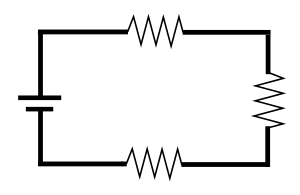Series and parallel circuits facts for kids
An electrical circuit is like a path for electricity to flow. There are two main ways to connect things in a circuit: in a series or in parallel. Understanding these two types helps us build all sorts of electronic devices, from flashlights to computers.
When parts are connected in a series, they are all lined up along a single path. Imagine a single road where all cars must pass through one checkpoint after another. The same amount of electricity flows through each part. However, the total electrical push (called voltage) gets shared among all the parts. If one part stops working, the whole path is broken, and electricity can't flow to any other parts.
When parts are connected in parallel, they are connected along multiple paths. Think of several roads leading to the same destination. Each part gets the full electrical push (voltage). The total electricity flowing from the source gets divided among these different paths. If one part stops working, electricity can still flow through the other paths, so the other parts keep working.
For example, imagine connecting four light bulbs to a 12-volt car battery. If you connect them one after another in a single loop back to the battery, they are in series. The same electricity goes through all of them. Each bulb only gets about 3 volts, which might not be enough to make them glow brightly. If one bulb breaks, all the other bulbs will go out too.
But if you connect each bulb directly to the battery in its own separate loop, they are in parallel. Each bulb gets the full 12 volts, so they will all glow brightly. If one bulb breaks, the others will stay lit because their paths to the battery are still complete.
Contents
Series Circuits: One Path for Power
In a series circuit, the electrical current has only one way to flow. It moves from a power source, like a battery, through one or more electrical loads (things that use electricity, such as a light bulb), and then back to the power source.
The amount of amperage (how much electricity is flowing) is the same through every single part in a series circuit. But the Voltage (the electrical push) gets split up among all the parts.
A key thing to remember about series circuits is that if any one part stops working, the entire circuit breaks. This means electricity can't flow anymore, and all the other parts will also stop working. This is why old Christmas tree lights used to have this problem: if one bulb burned out, the whole string went dark!
Parallel Circuits: Many Paths for Power

In a parallel circuit, the electrical current can flow along several different paths before returning to the power source. This is like having multiple lanes on a highway.
The Voltage (electrical push) is the same across all the parts in a parallel circuit. Each part gets the full power from the source. The total amperage from the power source gets divided up among all the different paths.
A great advantage of parallel circuits is that if one part stops working, the other parts connected in parallel will usually keep working. This is because their individual paths for electricity are still complete. Most homes use parallel wiring so that if one light bulb burns out, the other lights and appliances still work.
Real-World Uses of Circuits
Series and parallel circuits are used everywhere!
One common use of series circuits is in battery packs. Several battery cells are connected in series to get a higher total voltage. For example, a flashlight or a TV remote might use two 1.5-volt batteries connected in series to get a total of 3 volts. A powerful tool battery might have many cells in series to provide 48 volts.
In the past, some electric multiple units (trains) used series circuits for their lights. For instance, if the train's power supply was 600 volts, they might connect eight 70-volt light bulbs in series. This would use 560 volts, with a special part called a resistor to handle the extra 40 volts. However, newer trains use more advanced systems for their lighting.
See also
 In Spanish: Circuitos en serie y en paralelo para niños
In Spanish: Circuitos en serie y en paralelo para niños


